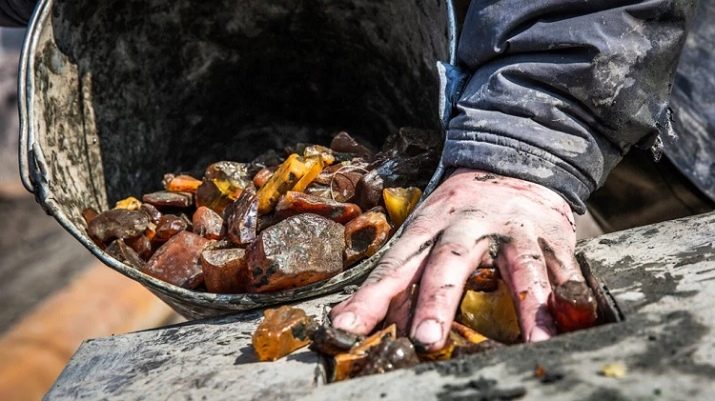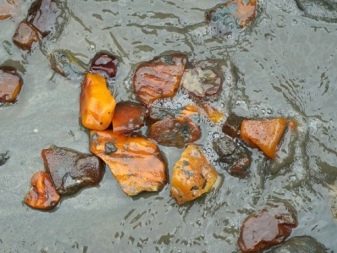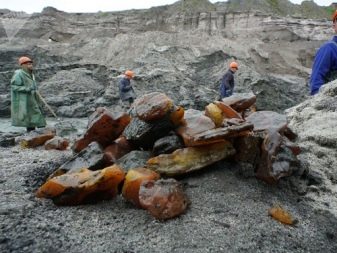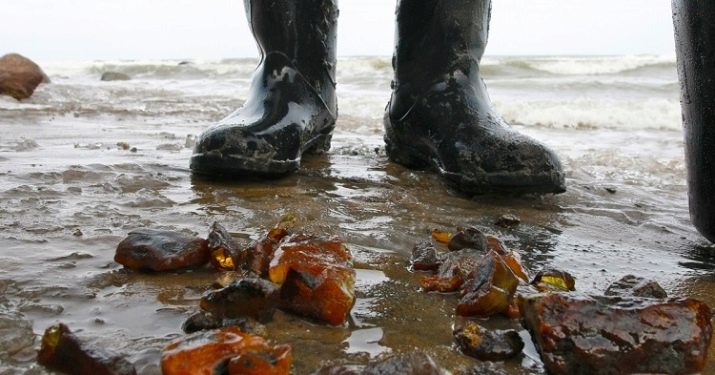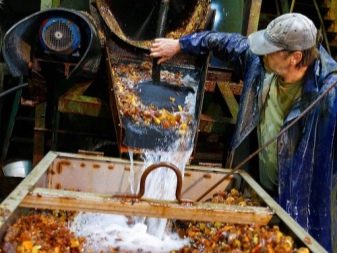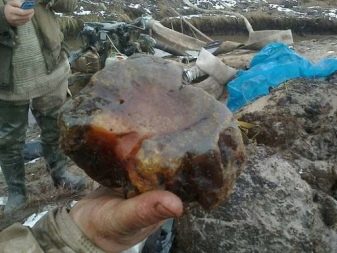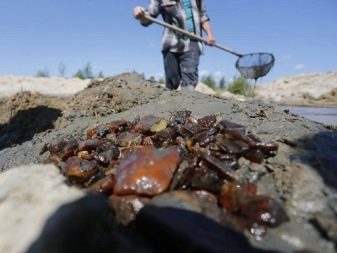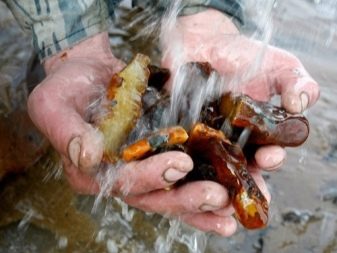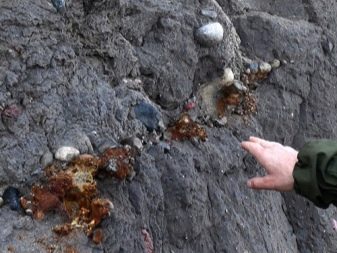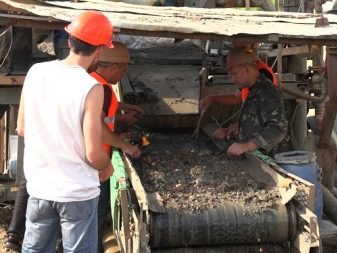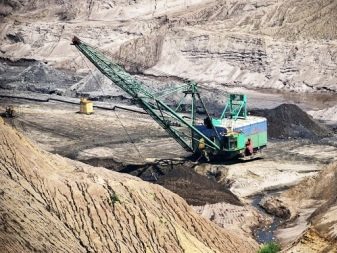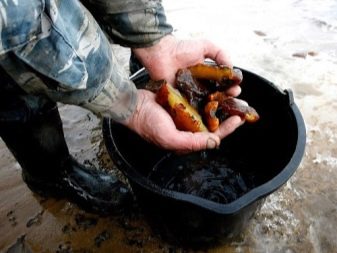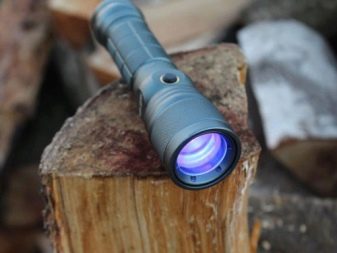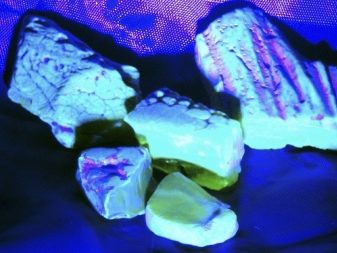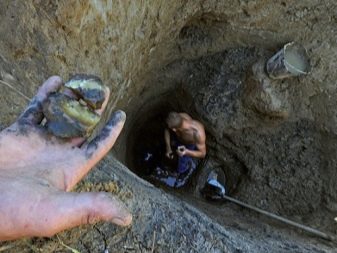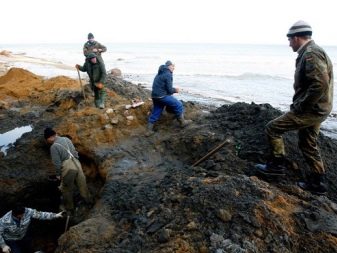How to catch the sun? This question is fairly easy to answer. The fact is that there is one stone that people associate with the sun and its energy. He is loved and honored, they make various crafts out of him. So a person is trying to keep the rays of the light next to him. What is this wonderful stone? It is easy to guess, we are talking about amber.
Types of deposits
This stone usually lies in the form of inclusions between coal seams. As a rule, the locations of amber are divided into two large groups.
- The first is primary or indigenous deposits. That stone, which is found in coal sediments, refers specifically to them. Also to the primary deposits include areas such as the North Siberian, Far Eastern, Ural. Everything is explained simply: there, where coniferous forests used to grow, and resin plentifully flowed from the trees, and amber appeared.
- The other group is secondary. Such deposits are called placers. They, in turn, are divided into sea and river. These deposits are located far from the primary (primary). And all because the stone was brought to future deposits by water streams, either by earthen debris, or by the advancement of glaciers.
That is, amber was not born there, but “emigrated” to these places by natural movements. As a result of the accumulation of natural material brought huge deposits.
Kaliningrad is considered to be the most famous place in Russia where solar stone is mined. Kaliningrad deposits belong to loose. On the example of the secondary sections, we can see one more division, now into discharges. They are delta, coastal, marine, marine, glacial.
Why amber deposits have a very low density? Because the resin does not sink in water. And amber is a petrified resin. Many centuries ago, the resin was carried by water streams for quite a long distance. Where the stream met an obstacle, the resin clung to the sand, mixed with fragments of trees. Time and natural phenomena created amber.
As a result of various transformations of such deposits, a great many appeared.
Today, people find sunny bits in various places. They can be found on the river bank, in various shallows, in fragments of vegetation. There they are taken down the river flow. Also, amber can be found at the foot of the mountains, it was demolished by a glacier.
Even pebbles can bring to the surface spring flood or storm. For example, as in the Kaliningrad region. On the coast of the oceans and seas, the sun mass carries a storm. In the 19th century, it was in the Kaliningrad region that a very large emission of gems occurred once. Residents collected stones for several days.
The world's largest deposits
If you start talking about large fields, then you need to start the story with Russia. The largest cluster of amber is located on the Baltic coast of the former Sambian, and now Kaliningrad, peninsula. To be precise, this is Yantarny (in this place is located about 90% of world reserves of stone). Amber is over fifty million years old. That is what experts say.
At this time, with the help of geological studies, experts have determined that there are new areas for development. Their reserves are about three hundred tons.
The field in the Kaliningrad region on the Baltic Sea is divided into three sections: Palmnikensky, Plyazhevy and Primorsky. The Palmniken area has been under development since 1976.According to geologists' estimates, the Palmniki and Primorsky quarries can supply people with amber for another two hundred years.
Annual production here is about 350 tons.
In the Rivne region, which is located in Ukraine, there are also stocks of amber. They are located in a kind of triangle of settlements Klesovo-Sarny-Dubrovitsy. Mining Ukrainian nuggets is cheaper due to the fact that they occur at a depth that ranges from 3 to 10 meters. 250 g of solar stone can be obtained from one cubic meter of earth formation.
The Dominican Republic is also famous for the extraction of amber. Here the age of the mountain stone is 40 million years. In Germany there is a field, which is located in Saxony-Anhalt. The age of amber here is about 22 million years.
The Baltic Center for Amber is located in Kaliningrad, followed by Lithuania. The local geological service is trying to announce an open international competition for the extraction of this stone. You can also find various amber souvenirs in large quantities in Estonia. Nuggets in these places are mined on the island of Saaremaa, and already of them make expensive gizmos.
Belarusians believe that amber deposits in their edges look like ghosts. The deposits of solar stone are depicted on maps of geologists and in scientific journals, but not everyone can see them personally. Pieces of nuggets are found on Paleolithic sites. Their age is about thirteen thousand years.
Belarusian exploration identified seven sites with deposits of amber. Stones occur in the Pinsk, Stolin, Luninets, Drogichinsky districts, in Polesye and in the Brest region. The most prominent in this regard are considered marshlands. deposits in the Gatcha massif near Zhabinka. More than three hundred tons of amber is stored there.
New deposits open in Latvia. Amber is found both on the shore and at the bottom of the sea. Alluvial deposits very often open at the bottom due to the fact that water moves huge layers of sand. As a result of this perturbation, the solar stone breaks out.
Lucky lovers find nuggets the size of a human fist at depth.
Where is mined in Russia?
By and large, it is easier to name the places where amber is not mined. The beginning of the fishing takes in the Kaliningrad region, and then it spreads throughout the country. And if the main reserves are located in Kaliningrad, then deposits were discovered in the north of Siberia and the Far East that helped these areas enter the Eurasian amber-bearing province of the world. As a result, even a brand appeared in Altai. It was invented by the locals for very high quality sunflower oil. It is called “Yantar of Altai”.
In addition, amber is found in Russia in the Urals, Primorsky Krai and Yakutia. Large nuggets are not found here, so industrial excavation of the sun stone in these places is impractical.
Mining methods
The process of extraction of solar stone is very diverse. For example, development can be carried out using the screw-hydraulic method. This is the safest way for both the environment and the state of the stone. The works are carried out as follows: with the help of auger-hydraulic equipment, wells are made in the ground. Their diameter is 80 cm.
Nuggets rise to the surface along with the ground under hydraulic pressure. Then they are cleaned, washed from the sand and earth. This is the most modern way.
And there is another way that provides for the organization of special careers. At first empty rocks are pulled out, then layers of blue clay become bare. It has amber.
However, this method is not safe, since a collapse can occur, so it is better to use the first method.
Previously, everything was different. In ancient times, amber was manually harvested on the shore, which is located along the Baltic Sea, and was put mining in special containers. This method made it possible to extract about sixty thousand tons of solar stone.Time passed, and our ancestors realized that getting a stone out of the water is much easier if using nets. Amber got into them along with algae.
Some seekers even “plowed” coastal zones so that a light stone washed out of the sea soil and floated to the surface. To get in nature solar stone is easy. It is located at a rather shallow depth. But for the organization of official production requires large costs, so there are "black" diggers.
Illegal booty is to use the hose of a huge vacuum cleaner. Standing knee-deep in water, people lift and lower an aluminum pipe attached to a gasoline pump into a pit of dirty water. So they wash out the soil (blue clay), which is more than 50 million years old. With this liquid, amber rises to the surface.
Catching amber in such pits is a rather difficult task. However, all costs and labor pays off with interest. A large stone in the "black" market is more expensive than a piece of gold of the same weight. Finding such a copy is a great success. Therefore, people are digging holes, not thinking about their health and environmental damage.
The authorities of the Russian Federation toughened the punishment for this activity in 2017. To date, the fine for illegal mining of amber is set at between 200 and 500 thousand rubles. Previously, he was only 3-5 thousand rubles. Officials will pay about 800 thousand rubles for violation, and the fine for legal entities will be calculated in millions (10-60 million rubles depending on the scale of illegal activities). Today, the sale of illegally mined amber, its transportation and storage for marketing purposes is strictly prohibited.
The above method is illegal.
But there are also people who combine the extraction of amber with passion. The search for the sun stone in the diving process does not violate the current legislation. How do divers look for amber at the bottom of the sea? They use the physical properties of stones. Fluorescence is the glow of stones in different colors under the influence of an ultraviolet lamp. Modern devices significantly increase the search efficiency, but you need to remember the following nuances:
- the error will be excluded if you bring the stone to the glass of the lamp itself;
- the lantern will shine brighter if space is limited;
- the degree of fluorescence of amber under water depends on the indicator of the wavelength range (it should be 360-400 nm);
- nuggets are easy to find if you use a lamp with a wavelength of 365 to 400 nm;
- when working with such equipment, it is recommended to use special glasses or polycarbonate glass;
- the highest power of the flashlight will provide a great glow effect.
The search for amber is not only an interesting geological hobby, but also a good salary.. "Black" diggers on average earn from 100 to 200 thousand rubles. per month. Divers put the hope of good luck, but their way is more like a hobby, although it is not without material meaning.
You can learn about how amber is mined and found by watching the video below.

